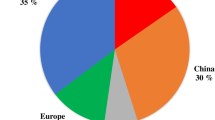Abstract
Thermodynamic and kinetic data are important for designing a CO2 absorption process using aqueous amine solutions. A piperazine derivative, 1-(2-aminoethyl)piperazine (AEP), was blended with aqueous amine solutions due to its thermal degradation stability, high CO2 loading (mole of CO2-absorbed per mole of amine) and high solubility in water. In this study, the vapor liquid equilibrium (VLE), absorption rate, and species distribution of aqueous AEP solutions were studied to develop an optimum amine solution in a post-combustion capture process. The VLE and apparent absorption rate of the aqueous 30wt% AEP solution were measured using a batch-type reactor at 313.15, 333.15, and 353.15 K. The AEP exhibited approximately twice higher CO2 loading compared with monoethanolamine (MEA) at all temperatures. The apparent AEP absorption rate (k app =0.1 min−1) was similar to that of diethanolamine (DEA) at 333.15 K. Speciation of the CO2-absorbed AEP was analyzed using 13C NMR. Although AEP featured a primary amino group and secondary amino group, it did not form bicarbamate upon reaction with CO2 based on analysis results. AEP-1-carbamate was primarily formed by reactions between AEP and CO2 during the initial reaction. Bicarbonate species formed as the quantity of absorbed CO2 increased.
Similar content being viewed by others
References
A. Albo, P. Luis and A. Irabin, Ind. Eng. Chem. Res., 49, 11045 (2010).
G. Marland, T. A. Boden and R. J. Andres, Global, regional, and national CO2 emissions, Trends: A compendium of data on global change, Statistical Review of World Energy (2010).
R. Allam and O. Bolland, IPCC special report: Carbon dioxide capture and storage, IPCC Working Group III (2005).
R. Thiruvenkatachari, S. Su, H. An and X. X. Yu, Prog. Energy Combust. Sci., 35, 438 (2009).
A. J. Applehy and F. R. Foulkes, Fuel Cell Handbook, Van Nostrand Reinhold, New York (1989).
C. Han, K. Graves, J. Neathery and K. Liu, Energy Environ. Res., 1, 67 (2011).
Y. E. Kim, J. H. Choi, S. C. Nam and Y. I. Yoon, Ind. Eng. Chem. Res., 50, 9306 (2011).
J. Davison, Energy, 32, 1163 (2007).
F. Closmann, T. Nguyen and G. T. Rochelle, Energy Procedia., 1, 1351 (2009).
D. Singh, E. Croiset, P. L. Douglas and M. A. Douglas, Energy Convers. Manage., 44, 3073 (2003).
R. Davy, Energy Procedia, 1, 885 (2009).
M. H. Li and K. P. Shen, Fluid Phase Equilib., 85, 129 (1993).
M. D. Cheng, A. R. Caparanga, A. N. Soriano and M. H. Li, J. Chem. Thermodyn., 742, 342 (2010).
F. Y. Jou, A. E. Mather and F. D. Otto, Can. J. Chem. Eng., 73, 140 (1995).
A. Veawab, P. Tontiwachwuthikul and A. Chakma, Ind. Eng. Chem. Res., 38, 3917 (1999).
A. Veawab, P. Toniwachwuthikul and S. D. Bhole, Ind. Eng. Chem. Res., 1, 36 (1997).
P. Singh, D. W. F. Brilman and M. J. Groeneveld, Energy Procedia, 1, 1257 (2009).
Y. Du, L. Li, O. Namjoshi, A. K. Voice, N. a. Fine and G. T. Rochelle, Energy Procedia., 37, 1621 (2013).
Y. Du and G. T. Rochelle, Energy Procedia, 63, 997 (2014).
R. Zhang, E. P. Bonnin-Nartker, G. A. Farthing, L. Ji, M. G. Klidas, M. E. Nelson and L. M. Rimpf, Energy Procedia., 4, 1660 (2011).
Y. Zhang, Ind. Eng. Chem. Res., 50, 163 (2011).
P. Jackson, K. J. Fisher and M. I. Attalla, Am. Soc. Mass. Spectrom., 22, 1420 (2011).
M. S. Islam, R. Yusoff and B. S. Ali, Engineering e-Transaction., 2, 97 (2010).
M. Caplow, J. Am. Chem. Soc., 90, 6795 (1968).
P. V. Danckwerts, Chem. Eng. Sci., 34, 443 (1979).
H.-B. Xie, Y. Zhou, Y. Zhang and J. K. Johnson, J. Phys. Chem. A., 114, 11844 (2010).
F. Barzagli, F. Mani and M. Peruzzini, Energy Environ. Sci., 2, 322 (2009).
A. K. Chakraborty, K. B. Bischoff, G. Astarita and J. R. Damewood, J. Am. Chem. Soc., 110, 6947 (1988).
D. Prakash, E. Vaidya and Y. Kenig, Chem. Eng. Technol., 30, 1467 (2007).
F. Barzagli, F. Mani and M. Peruzzini, Inter. J. Greenhouse Gas Control, 5, 448 (2011).
C. Perinu, B. Arstad and K.-J. Jens, Int. J. Greenhouse Gas Control, 20, 230 (2014).
J. H. Choi, S. G. Oh, Y. E. Kim, Y. I. Yoon and S. C. Nam, Environ. Eng. Sci., 29, 328 (2012).
I. H. Um, M. J. Kim, J. S. Min and D. S. Kwon, Bull. Korean Chem. Soc., 15, 523 (1997).
J. H. Choi, S. G. Oh, Y. I. Yoon, S. K. Jeong, K. R. Jang and S. C. Nam, J. Ind. Eng. Chem., 18, 568 (2012).
A. F. Ciftja, A. H. Hartono and H. F. Svendsen, Int. J. Greenhouse Gas Control, 16, 224 (2013).
Author information
Authors and Affiliations
Corresponding author
Additional information
This article is dedicated to Prof. Sung Hyun Kim on the occasion of his retirement from Korea University.
Rights and permissions
About this article
Cite this article
Choi, J.H., Kim, Y.E., Nam, S.C. et al. CO2 absorption characteristics of a piperazine derivative with primary, secondary, and tertiary amino groups. Korean J. Chem. Eng. 33, 3222–3230 (2016). https://doi.org/10.1007/s11814-016-0180-9
Received:
Accepted:
Published:
Issue Date:
DOI: https://doi.org/10.1007/s11814-016-0180-9




